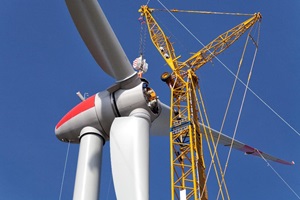- Wind Turbine Blades
- Energy Technologies
- Energy Technologies
- Mergers Acquisitions
- Wind Turbine OEMs
What GE’s LM Wind Power Acquisition Means for the Wind Industry

The wind power markets awoke to the surprise news on Tuesday morning that US industrial conglomerate GE had inked a $1.65 billion deal to acquire LM Wind Power, the world’s largest independent wind blade manufacturer.
This acquisition represents a major shake-up in the global wind market on a number of levels, primarily because Denmark-based LM has more blade capacity installed and turbine supplier relationships than any other blade vendor. LM has the capability to produce almost 10,000 blades annually from 13 factories, representing around 6.3 GW of capacity. This is approximately a 17% market share among 18 global independent wind blade manufacturers, as assessed by Guidehouse Insights for the upcoming Wind Turbine Blade Technology & Supply Chain Assessment report. The company’s blades are installed on over 77 GW of the world’s 432 GW of wind turbine capacity globally.
Up until now, GE has outsourced 100% of its blade capacity, with LM as its largest supplier. Most turbine OEMs favor a blade sourcing strategy of make-and-buy, which blends in-house supply with outsourcing to guarantee supply while maintaining better flexibility. Bringing production in-house is a strategy for GE to ensure critical blade supply with a make-and-buy sourcing strategy.
GE also says that with blades and rotors being such a critical part of the wind turbine, this is the ideal time to fully bring blade manufacturing capabilities in-house where GE can leverage its skills in system design, materials science, and analytics skills to better optimize blades with a whole turbine approach.
M&A Continues to Shake Up Market
Leveraging GE’s manufacturing aptitude is one part of this deal, but so too is its competitive strategy. The wind turbine market is in a phase of consolidation, with a number of other high-profile M&A deals inked over the past few years. Notable examples include Siemens and Gamesa, GE and Alstom, Nordex and Acciona, Vestas and Mitsubishi, ZF and Bosch Rexroth, Vestas’ acquisitions of UpWind and Availon, and Siemens and Adwen.
Interestingly, Siemens recently announced for the first time since it entered the wind business in 2005 that it would partner with LM to have LM build blades for its new low-wind 3.15-142 turbine. This is purely speculation, but GE’s acquisition of LM could be a preemptive move on GE’s part to prevent Siemens from acquiring LM. Following Siemens’ acquisition of Gamesa this year, the German conglomerate needs to harmonize its blade manufacturing strategy since Siemens manufactures blades differently than Gamesa.
Siemens produces all of its blades in-house with a unique one-piece molding process, while Gamesa builds 2-piece bonded shell designs and also outsources, with LM as one of its largest suppliers. The Siemens manufacturing process is reportedly more expensive than the process built by Gamesa. Siemens would likely have benefited from the acquisition of LM in order to reduce its blade manufacturing costs and harmonize its blade sourcing strategy.
How GE’s acquisition of LM will affect other players depends partly on how much of LM’s manufacturing capacity will be allocated to GE’s needs. GE says it will operate LM as a standalone company that will retain all of its previous turbine customer relationships. But the wind blade market is a highly competitive landscape, rife with intellectual property concerns. Would other turbine OEMs truly consider LM independent and feel they are getting the same value as LM’s parent GE, their competitor?
Conversely, is a blade company under GE’s control likely to sell blades to GE’s competitors at the same capacity levels, especially if GE increases its in-house sourcing from LM for its own needs? In general, there still is an oversupply globally of wind blade manufacturing capacity, but this move by GE could tighten supply among the Western wind turbine OEMs and shift capacity around among other independent blade suppliers.